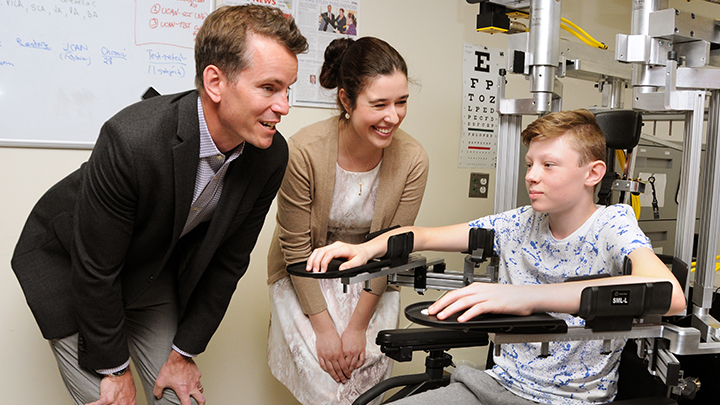
April 7, 2016

Perinatal stroke researchers Dr. Adam Kirton, left, and Andrea Kuczynski watch as 12-year-old Max Challoner takes part in a study using the KINARM robotic device to assess position sense in children with early brain injuries at Foothills Medical Centre. Max’s contribution may help to develop personalized rehabilitation therapies.
Story by Greg Harris; photo by Paul Rotzinger
CALGARY — It’s not very often you can do your part for medical science by playing video games while strapped into a robotic device that measures your responses.
Yet this is the reality for 12-year-old Max Challoner, who suffered a stroke around the time he was born that left him with mild physical impairments on his right side.
Max recently took part in a Calgary study that used the robotic technology to study deficits in position sense — otherwise known as proprioception — in children who’ve had a perinatal stroke. Researchers hope their findings will lay the groundwork for developing new therapies for children with early brain injuries.
“It feels good to know you’re doing something that could one day help out other kids,” Max says of his role in the research.
Max’s mom, Wendy Saunders, adds: “Getting involved in the research has helped us learn more about some of the issues surrounding perinatal stroke. The possibility that this could one day lead to tailored treatments for Max and other kids is quite exciting.”
It’s believed this is the first time that anyone has used this technology to study deficits in position sense in children who have had a perinatal stroke, which often results in cerebral palsy.
Position sense can be described as your unconscious perception of where your body is while in motion or at rest; for instance, closing your eyes and touching your nose requires position sense.
“Most of the research and therapeutic focus has targeted motor deficits in an effort to help children improve their physical abilities,” says Dr. Adam Kirton, an Alberta Health Services (AHS) specialist in perinatal stroke and the senior researcher on the study.
“Measuring deficits in position sense will create a fuller picture of each patient’s condition. Armed with that information, it might be possible to develop personalized rehabilitation therapies that are more effective than what we have now,” says Kirton, who’s also an associate professor at the University of Calgary’s Cumming School of Medicine in the departments of pediatrics and clinical neurosciences, as well as a member of the Alberta Children’s Hospital Research Institute.
About 1,000 Alberta children are currently living with the after-effects of perinatal stroke. The perinatal period extends from the 20th week of gestation to shortly after birth. There are different types of perinatal stroke that cause different brain injuries. Cerebral palsy is often a secondary outcome that affects muscle movement and motor skills.
“Someone whose position sense has been affected might have difficulty knowing where their hand or arm is in space, adding to their difficulty in using their affected, weaker limb,” says Dr. Kirton. “We can try to make a hand stronger but, if your brain doesn’t know where the hand is, this may not translate into meaningful function in daily life.”
Andrea Kuczynski, a PhD candidate with the University of Calgary, has led the ongoing research using the KINARM (Kinesiological Instrument for Normal and Altered Reaching Movements) robotic device at the Foothills Medical Centre.
Kuczynski tested 40 children who had a perinatal stroke and compared their results with those of a healthy control group. Children sat in the KINARM with their arms supported by the exoskeleton, which measured movement as they played video games and completed various tasks.
All the children also underwent magnetic resonance imaging, which gives researchers detailed pictures of brain structure. This allows researchers to describe the differences in major sensory and motor tracks in the brain, and how this might relate to function.
“Without technology like this, it’s next to impossible to objectively measure position sense,” says Kuczynski.
“In the future, the KINARM could be used as a tool for rehabilitation. Once we have an understanding of how an individual’s position sense has been affected, we can begin to focus and personalize rehabilitation.”